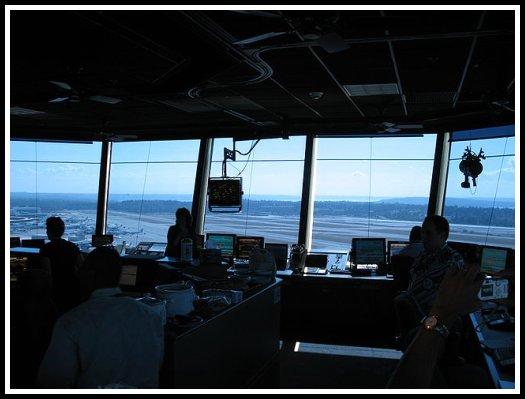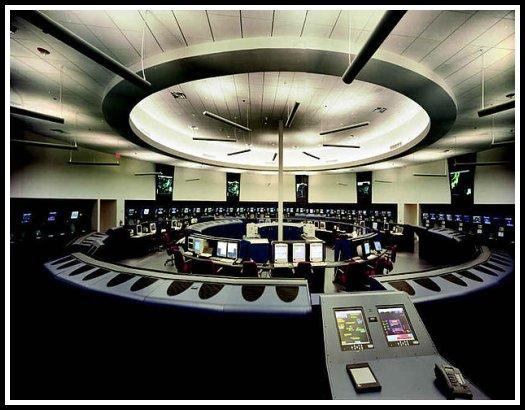Airport Control definition and classification
Put your compass on 'E' and get out of my airspace.
- ORD ATC.

Airport control
Pursuant to requirements of the International Civil Aviation Organization (ICAO), ATC operations are conducted either in the English language or the language used by the station on the ground. In practice, the native language for a region is normally used, however the English language must be used upon request.
The primary method of controlling the immediate airport environment is visual observation from the airport traffic control tower (ATCT). The ATCT is a tall, windowed structure located on the airport grounds. Aerodrome or Tower controllers are responsible for the separation and efficient movement of aircraft and vehicles operating on the taxiways and runways of the airport itself, and aircraft in the air near the airport, generally 5 to 10 nautical miles (9 to 18 km) depending on the airport procedures.
Radar displays are also available to controllers at some airports. Controllers may use a radar system called Secondary Surveillance Radar for airborne traffic approaching and departing. These displays include a map of the area, the position of various aircraft, and data tags that include aircraft identification, speed, heading, and other information described in local procedures.
The areas of responsibility for ATCT controllers fall into three general operational disciplines:
- Local Control or Air Control
- Ground Control
- Flight data / Clearance delivery
Other categories, such as Apron Control or Ground Movement Planner, may exist at extremely busy airports. While each ATCT may have unique airport-specific procedures, such as multiple teams of controllers ('crews') at major or complex airports with multiple runways, the following provides a general concept of the delegation of responsibilities within the ATCT environment.
Remote and Virtual Tower (RVT) is a system based on air traffic controllers being located somewhere other than at the local airport tower and still able to provide air traffic control services. Displays for the air traffic controllers may be either optical live video and/or synthetic images based on surveillance sensor data.
Apron Control Tower East at Frankfurt Airport
Ground control
Ground Control (sometimes known as Ground Movement Control abbreviated to GMC or Surface Movement Control abbreviated to SMC) is responsible for the airport "movement" areas, as well as areas not released to the airlines or other users. This generally includes all taxiways, inactive runways, holding areas, and some transitional aprons or intersections where aircraft arrive, having vacated the runway or departure gate. Exact areas and control responsibilities are clearly defined in local documents and agreements at each airport. Any aircraft, vehicle, or person walking or working in these areas is required to have clearance from Ground Control. This is normally done via VHF/UHF radio, but there may be special cases where other processes are used. Most aircraft and airside vehicles have radios. Aircraft or vehicles without radios must respond to ATC instructions via aviation light signals or else be led by vehicles with radios. People working on the airport surface normally have a communications link through which they can communicate with Ground Control, commonly either by handheld radio or even cell phone. Ground Control is vital to the smooth operation of the airport, because this position impacts the sequencing of departure aircraft, affecting the safety and efficiency of the airport's operation.
Some busier airports have Surface Movement Radar (SMR), such as, ASDE-3, AMASS or ASDE-X, designed to display aircraft and vehicles on the ground. These are used by Ground Control as an additional tool to control ground traffic, particularly at night or in poor visibility. There are a wide range of capabilities on these systems as they are being modernized. Older systems will display a map of the airport and the target. Newer systems include the capability to display higher quality mapping, radar target, data blocks, and safety alerts, and to interface with other systems such as digital flight strips.
Local Control / Tower Control
Local Control (known to pilots as "Tower" or "Tower Control") is responsible for the active runway surfaces. Local Control clears aircraft for takeoff or landing, ensuring that prescribed runway separation will exist at all times. If Local Control detects any unsafe condition, a landing aircraft may be told to "go-around" and be re-sequenced into the landing pattern by the approach or terminal area controller.
Within the ATCT, a highly disciplined communications process between Local Control and Ground Control is an absolute necessity. Ground Control must request and gain approval from Local Control to cross any active runway with any aircraft or vehicle. Likewise, Local Control must ensure that Ground Control is aware of any operations that will impact the taxiways, and work with the approach radar controllers to create "holes" or "gaps" in the arrival traffic to allow taxiing traffic to cross runways and to allow departing aircraft to take off. Crew Resource Management (CRM) procedures are often used to ensure this communication process is efficient and clear, although this is not as prevalent as CRM for pilots.
Flight data / Clearance delivery
Clearance delivery is the position that issues route clearances to aircraft, typically before they commence taxiing. These contain details of the route that the aircraft is expected to fly after departure. Clearance Delivery or, at busy airports, the Traffic Management Coordinator (TMC) will, if necessary, coordinate with the En-route Center and National Command Center or Flow Control to obtain releases for aircraft. Often, however, such releases are given automatically or are controlled by local agreements allowing "free-flow" departures. When weather or extremely high demand for a certain airport or airspace becomes a factor, there may be ground "stops" (or "slot delays") or re-routes may be necessary to ensure the system does not get overloaded. The primary responsibility of Clearance delivery is to ensure that the aircraft have the proper route and slot time. This information is also coordinated with the En-route Center and Ground Control in order to ensure that the aircraft reaches the runway in time to meet the slot time provided by the command center. At some airports, Clearance delivery also plans aircraft push-backs and engine starts, in which case it is known as the Ground Movement Planner (GMP): this position is particularly important at heavily congested airports to prevent taxiway and apron gridlock.
Flight data (which is routinely combined with Clearance delivery) is the position that is responsible for ensuring that both controllers and pilots have the most current information: pertinent weather changes, outages, airport ground delays/ground stops, runway closures, etc. Flight data may inform the pilots using a recorded continuous loop on a specific frequency known as the Automatic Terminal Information Service (ATIS).

Approach and Terminal Control
Many airports have a radar control facility that is associated with the airport. In most countries, this is referred to as Terminal Control. In the U.S., it is referred to as a TRACON (Terminal Radar Approach Control). While every airport varies, terminal controllers usually handle traffic in a 30-50 nautical mile (56-93 km) radius from the airport. Where there are many busy airports close together, one consolidated TRACON may service all the airports. The airspace boundaries and altitudes assigned to a TRACON, which vary widely from airport to airport, are based on factors such as traffic flows, neighboring airports and terrain. A large and complex example is the London Terminal Control Centre which controls traffic for five main London airports up to 20,000 feet (6,100 m) and out to 100 nautical miles (190 km).
Terminal controllers are responsible for providing all ATC services within their airspace. Traffic flow is broadly divided into departures, arrivals, and overflights. As aircraft move in and out of the terminal airspace, they are handed off to the next appropriate control facility (a control tower, an en-route control facility, or a bordering terminal or approach control). Terminal control is responsible for ensuring that aircraft are at an appropriate altitude when they are handed off, and that aircraft arrive at a suitable rate for landing.
Not all airports have a radar approach or terminal control available. In this case, the En-route Center or a neighboring terminal or approach control may co-ordinate directly with the tower on the airport and vector inbound aircraft to a position from where they can land visually. At some of these airports, the tower may provide a non-radar procedural approach service to arriving aircraft handed over from a radar unit before they are visual to land. Some units also have a dedicated approach unit which can provide the procedural approach service either all the time or for any periods of radar outage for any reason.
World's Busiest Control Tower conversations @ KOSH (Oshkosh's Wittman Regional Airport, Wisconsin, USA.).mp3
UTC | Zulu Time